No-see-ums sneaked into the hair, eyes, and mouths of the investigators, biting. Buzzing black flies and deer flies added large welts to neck, face, and hands. Even with protective spray and long pants and sleeves, no one escaped the insects.
As workers stumbled over a log, beetles and other insects, along with centipedes and millipedes, scampered for a new hiding place. When researchers grabbed a tree trunk to help pull themselves up a trail, green caterpillars squashed under their hands.
Caterpillar frass pattered like raindrops on the leaves. The hard, round, rice-sized pellets were the digestive discharge from the caterpillars, leftovers from the flat green leaves eaten and used as nutrients for caterpillar life needs. Onto hats, into heads of hair and plastic collecting funnels, the frass fell.
During the first years of ornithology investigation a green moth larva with a red saddle-shaped marking on its back seemed to be everywhere. The caterpillars, in different sizes and stages, were constantly munching leaves. The bare tracery of leaf veins was their calling card. Leaves melted away in their busy mouth parts. Always eating and always on the move to more green leafy material, they ate their way through one skin-splitting size to the next.
The birders, watching the foraging activities of the birds, could quickly see that insects were an important food for many of the birds.
As ecologists, the ornithologists were aware that an important part of the terrestrial life in the ecosystem was not being studied. The big ecosystem puzzle would have one large, empty hole. While Dick and Frank looked at birds, Tom Burton studied the “herps” and Gary studied the mammals. But no one studied the insects, especially the busy caterpillars.
An entomologist – an insect specialist – was needed. But none was on the scene or coming. As ecologists, the principal bird investigators had wide backgrounds in terrestrial organisms. Curiosity about what was happening in the insect world prompted them to call on this background and expand their study to include the insects. They would study the insects in relationship to the birds. What insects were available for bird food? How many insects were available? Which insects did the birds eat?
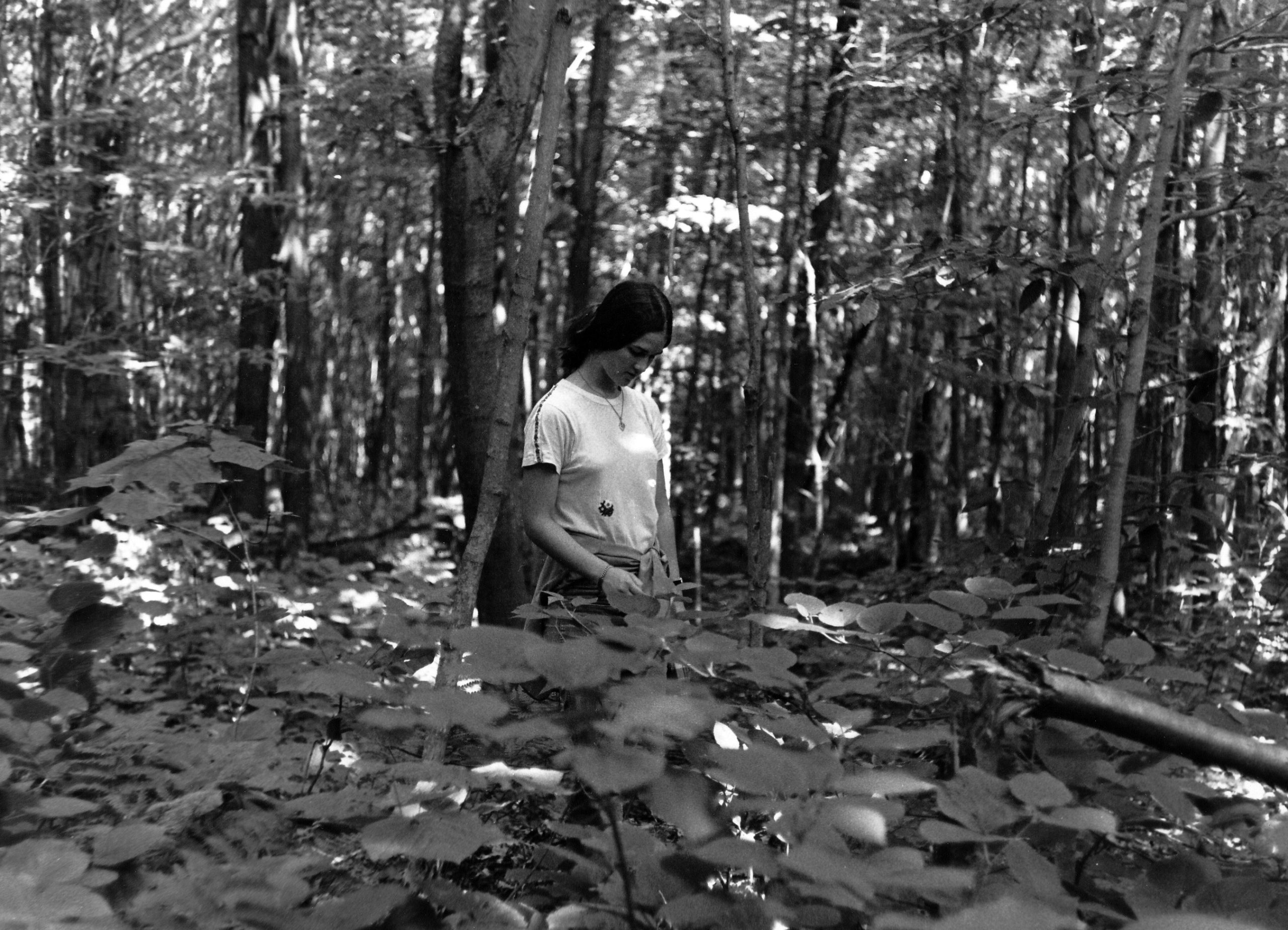
More questions followed: Which insects were most abundant? Was it possible to estimate their numbers? How were they distributed? Did they fly in the open, just around plants, near the forest canopy or the forest floor, and where in between? After the insects and their behavior had been described by answering these questions, new questions would describe their role in the ecosystem.
What did the most abundant insects eat? What was the nutrient content of the insect population? What were the total roles of the insects in nutrient cycling compared to other animal populations? Did the insects move the forest nutrients around a lot or very little?
It would take years to get the answers to all these questions. But when the answers came, the forest study would have more base lines – numbers that could be compared in the future. It would take several years to develop field techniques, or ways of collecting, that would enable reliable data, or numbers, to build up.
Thinking up the methods and procedures to find the answers to the questions was a creative and inventive part of the research. A forest lab is not as easy to manipulate or control as an indoor laboratory. Accurate measurements are harder to get. Weather alone may spoil several days or weeks for data-collecting.
The new entomology team decided their first job was to find out more about the life cycle of the green caterpillar. Their second job was to figure out how to get samples of insects from different heights in the forest. The third job was to find someone who could help identify insects. Their last job was to analyze the data.
Whenever scientists begin a study, they turn to the reports of others. They read articles by scientists who have faced similar problems. Reading may give them some ideas for solving their own research problems. What is not known or reported by others, scientists must discover for themselves. Then they will write up their methods and discoveries to share.
The printed reports suggested a population cycle of about ten years for Heterocampa, the smooth green caterpillar with brown spots and a red saddle in some of its stages. The population numbers would increase and then go down until the caterpillar was almost gone. The investigators could observe the caterpillar and see if the same cycle happened in their forest. If it did, they could expect another peak in numbers about 1980.
In order to count Heterocampa, the researchers had to be able to recognize it in its different stages, or instars, in the field. So they put one of the student assistants in charge of a caterpillar nursery. Dot learned about the life history of Heterocampa. Heterocampa was the genus name for a group of moths. “Saddled prominent” was the type of Heterocampa that Dot was trying to raise and observe. She learned to recognize each of its five instars. She discovered how much each instar ate and how much frass each one produced. She found they really liked beech leaves.
Very small Heterocampa were put into pint glass canning jars with the leaves they had been eating when they were plucked from a tree. Tree limbs had to be cut and leaves picked to keep them munching.
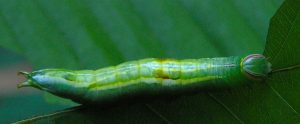
Small problems popped up. The cotton cheesecloth squares that covered the jars were held in place by wide rubber bands. Small caterpillars crawled up the jars, over the lip, under the cheesecloth, and escaped down the spiral threads at the top of the jar like a hiker winding down a mountain trail. Metal lids were out because Dot was keeping caterpillars, not canning them. They needed air to stay alive!
In the dining room Pat Sturges watched as escaping caterpillars were caught and returned to their jars. She thought awhile and suggested trying the screw rings that usually came with canning jars, but keeping the cheesecloth lids. Dot tried it. Sure enough, the rings twisted the cheesecloth into the glass threads and blocked the escape route of the caterpillars.
Dot observed the growing larvae. She took notes about their size, shape, appearance, and the number of leaves each larva ate each day. As they shed their skins and grew bigger, she had to watch each molt carefully so she would be able to recognize the original larva through all its instars. “Look at this one!” she yelled, focusing the binocular microscope. Everyone looked so they could recognize the instars too. Dot described each stage in her notebook to help the other researchers identify them. In the first instar horns appeared on the head. The third instar no longer had horns, but showed a saddle on its back. The fifth instar dropped to the ground and burrowed in the litter as a pupa with a hard covering. The next summer an adult moth would emerge from the pupa.
The saddled prominents made good food for the captive birds awaiting transport to the biology lab at Dartmouth College where respiration studies of them took place.
Birds eat a lot. The supply of live Heterocampa was often low. So sometimes Frank and his family went Heterocampa picking in the woods outside the experimental forest zones. As if they were blackberry picking, they found each caterpillar, plucked it from its leaf, and put it in a plastic bag. Finding the well-camouflaged green caterpillars was difficult. The caterpillars matched the piece of leaf they were eating. Sharp eyes were needed to spot them. Often clues were used to locate them – a half-eaten leaf, veins on a half leafless tree. A visitor in the woods might have thought the season was fall rather than summer – so many trees had lost a large part of their leaves.
Frass collection was one way of trying to estimate the number of insects in the forest. Dot recorded the weight of leaves put in each jar and the amount of frass taken from each jar. Soon the researchers could tell how much frass was made by one insect’s eating a certain mass of leaves. Using Jim’s measurements of frass in the field, they figured the number of leaves eaten and the number of caterpillars needed to eat that number of leaves and make the measured amount of frass: Frass weight tells leaf weight tells number of caterpillars (F→L→C).
Another way of estimating the relative number of insects in the forest was to trap them and count them. Stationary traps were put out at special places near the bird grid and checked regularly. The researchers figured out how many insects per day, per week, and so on, were caught.
Several kinds of traps were used to see which ones worked best in this forest. Aerial nets, night-light traps, glass and water traps, malaise net traps, a suction trap, and a poison bag trap were tried.
A stick with an attached cone-shaped net made an aerial net. With this butterfly net a collector made measured sweeps through the air at regular heights a certain number of times a day and week. There are standard ways for using this net. The insects were removed from the net and placed in a killing jar.

The jar contained a poison deadly not only to insects, but to humans too. Plaster of paris was hardened over potassium cyanide, sealing the poison off from the rest of the jar. A blotter covered the plaster of paris. Fumes seeping through killed the insects painlessly in seconds. The collector was very careful not to touch or smell the poison or drop the bottle.
An entomology student told the children at the station that his jar was too dangerous for them to use. After they swept the meadows with their nets to collect their own insects, they used their own killing jars. Ethyl acetate, or fingernail polish remover, was soaked in cotton and stapled to the cardboard liners in the lids of their bottles.
Battery-operated light traps with ultraviolet bulbs were set out in the forest to catch night-flying insects. Placed over a bucket holding poison, the light attracted insects, which were overcome by the fumes and dropped into the bucket. This trap was used one night every two weeks. Researchers only wished to sample what was there, not to kill everything in the trapping area.
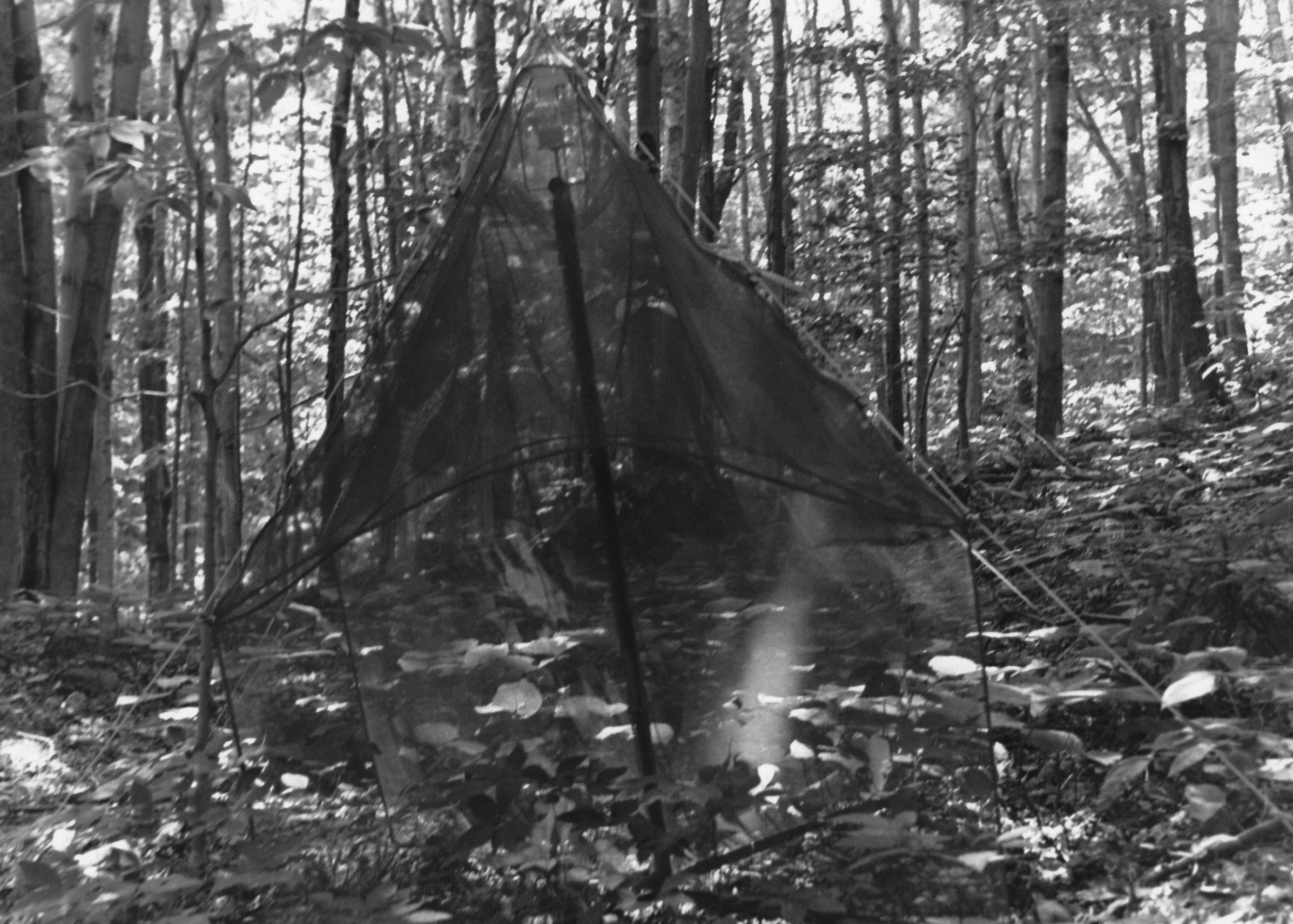
The glass and water trap was made of a 1 ½-foot square of clear rigid plastic. A 3 ½-foot two-legged frame supported it vertically above the ground. Insects flying through the forest hit the plastic and fell into the water-filled trough under the glass. Detergent in the water wetted the flying insects and caused them to sink and drown. When the board split and leaked, data were lost and researchers were frustrated.

Malaise net traps looked like a net tent with a center pole. Four flaps, or vanes, were held out with rope, making four corners to the “tent.” Insects hit the vanes, crawled upward instinctively, climbed into the clear glass at the top center point of the tent, and fell into a funnel that led to a poison jar. Every two days the insects were collected.
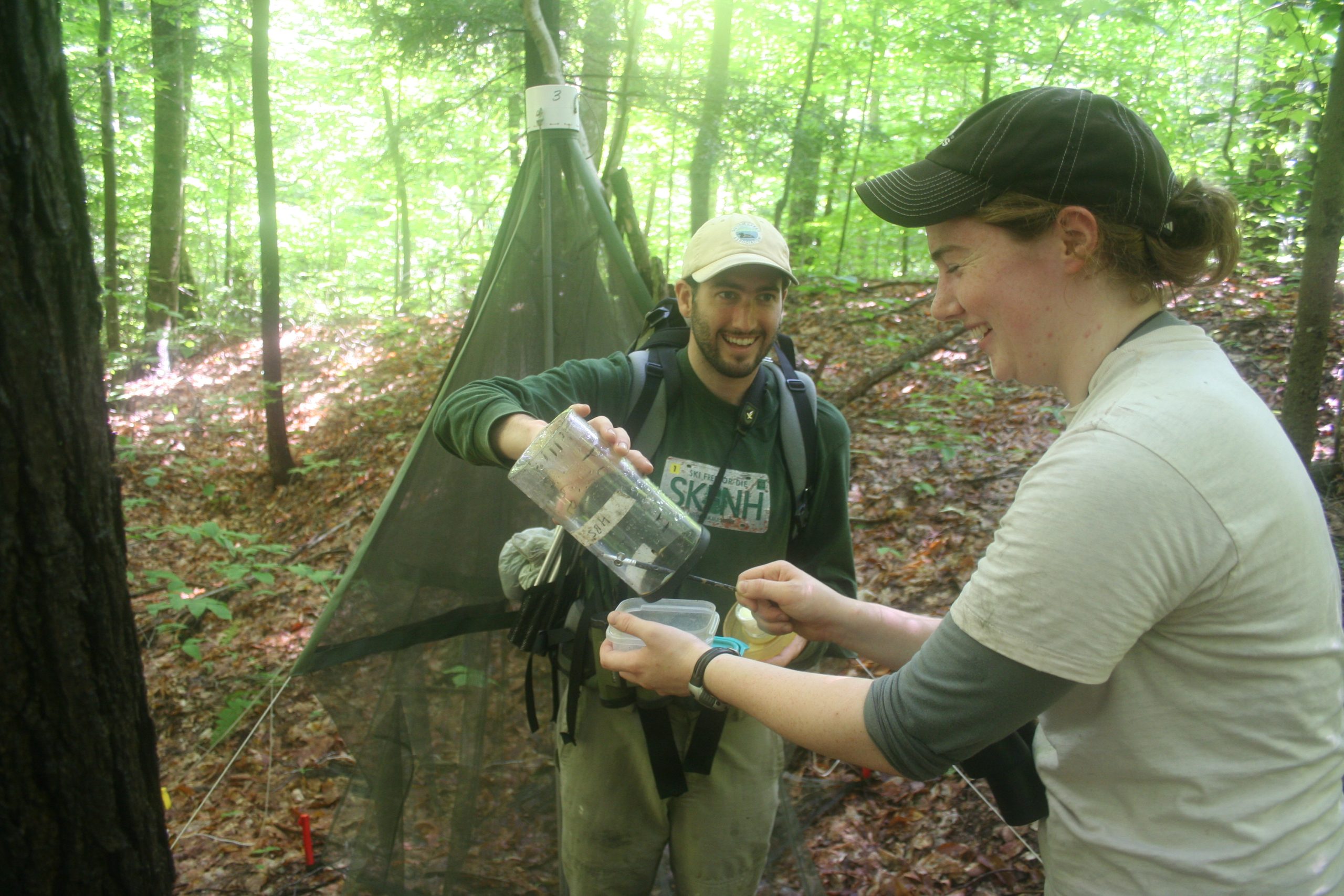
Ideas to solve problems might come from any place. The suction trap was an idea that Dick brought back with him from a stay in England. Used there in farming, it now collected forest insects. An electrically run fan created a suction and moved air down through a fine mesh screen cone. Insects in the air near the trap were pulled down with the airstream into a collecting cylinder below. Each hour a round disk fell and separated insects according to the hour they were collected. The cylinder containing the collection of insects was removed once a day. Each layer of insects was put into a separate small envelope and labeled by date, hour, and the height of the trap.
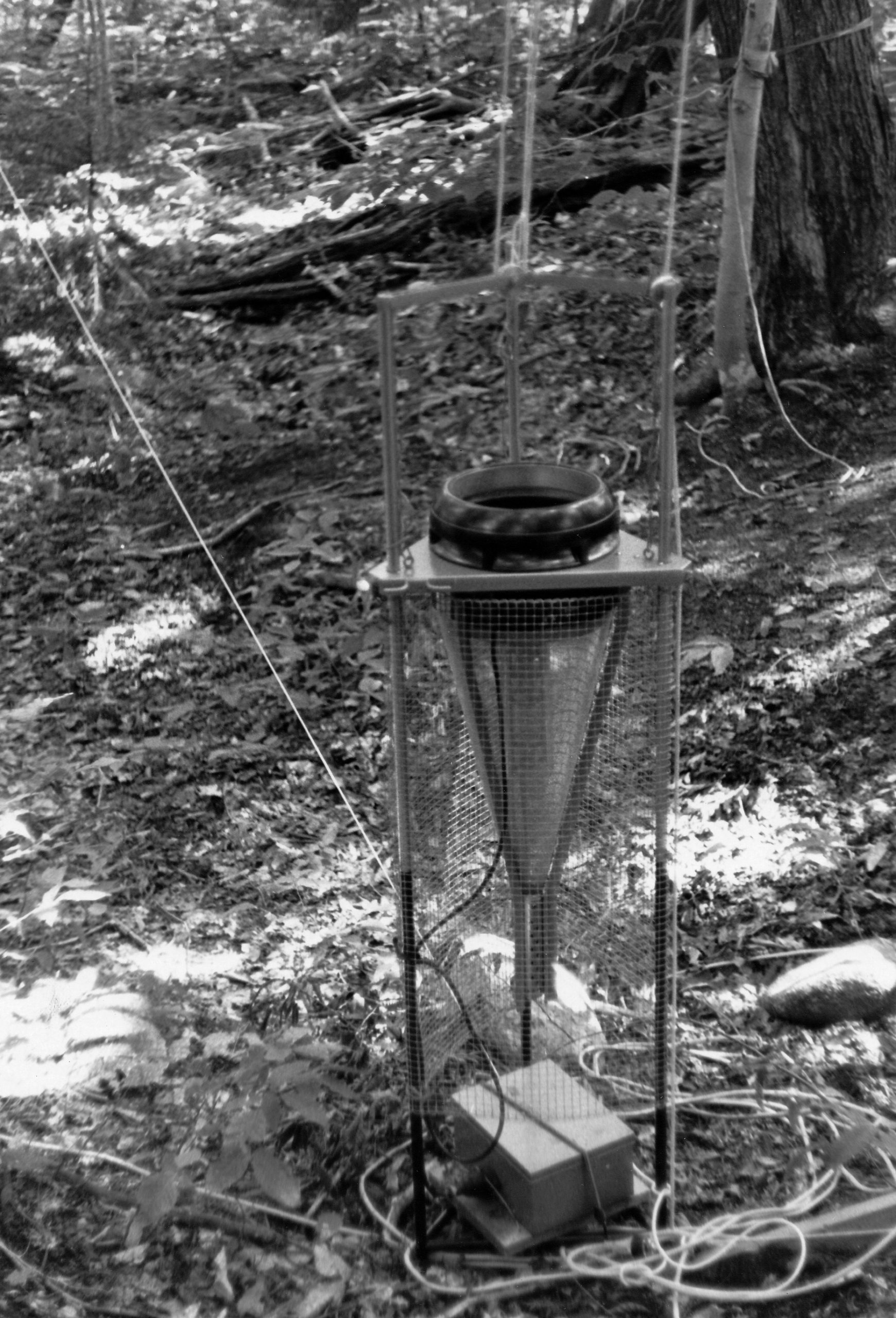
How to plug in an electrically operated suction trap in the woods was a problem with a quick answer – use a gasoline engine to run two automotive alternators that make electricity and send 12-volt charges into a storage battery. An automobile electric light system works in a similar way. But the suction fan needed 110-volt alternating current to run. So, after leaving the batteries, the 12 volts were put through a small square converter box to be changed into the necessary 110-volt alternating current. Then the suction fan could be plugged in. The answer came quickly, but getting everything into the forest and working was another story.
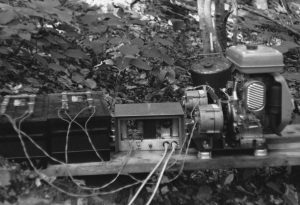
For three frustrating weeks much of the researchers’ time was spent trying to make machinery work. Luckily they had the help of a college technician. His job was keeping the college scientific instruments and equipment running and the scientists working. He also devised new equipment to do specialized jobs. He now used some of his own time to visit the woods and work out the kinks in the heavy, cumbersome equipment. Finally, gasoline energy was successfully changed into electrical energy. The fans under the traps hummed quietly. The disks gave a metallic clink hourly as an electric current released a metal lever that held the twenty-four disks in place.
A king-sized sheet of heavy plastic was anchored at four corners to make a protective tent over the machinery. The equipment to keep two traps running took several times the space of the two three-foot traps.
Craig collected insects by putting a poisoned bag over branches of the trees used by the black-throated blue warbler. He shook the contents of a branch into a bag. Later he identified and counted the insects in the bag to learn which ones were possible food for his birds.
All these traps caught insects near the forest floor. But how to sample the canopy of trees fifty feet to seventy feet tall?
Everyone brainstormed. Suggestions flew. The investigators and their friends said anything that came into their heads while trying to figure out what could work:
Spikes and a safety belt – too dangerous for inexperienced climbers. Broken body parts mend slowly.
Use a cherry picker such as the telephone and electric men use to reach high wires. The farmers used similar mechanical baskets to stand in while picking the tops of their trees. Why not pick insects the same way? No roads. Too difficult to get into the forest without upsetting the outdoor laboratory.
Hire a smart monkey – ridiculous!
What about a high, open tower like the one on Watershed 6? Air temperatures were measured at different elevations – why not measure insects the same way?
And so the suggestions came.
Using the framework open tower seemed the most practical idea. Tower sampling would be supplemented with the help of a professional tree climber. Later Dick would adapt the air sampler even further with ropes swung Tarzan-style to the tops of the trees.
At first, the idea of climbing trees had not appealed to all the researchers – one had experienced a fall. On second thought the idea did seem workable, if they could get an expert to do the climbing. Rod was their man. He was a professional tree trimmer and pole climber. He knew how to use a safety rope to break a fall in case his spikes let him down.
So the entomology researchers hired Rod to climb for them every ten days for eight weeks. Each time, a total of approximately 64,800 leaves (18 trees times 3,600 leaves) were examined for any sign of insects.
At random Frank or Dick picked out representative trees. Rod started the upward climb, moving his hands up the tree trunk as he scampered to the top part. Instead of a smart monkey, they had found a smart man who could climb like a monkey.
Rod had had falls during his career, but he had always gone back to his chosen occupation. He put the researchers’ hearts in their throats a couple of times. His spikes slipped, and he made a free fall halfway down the tree before his rope jerked him to a stop.
Rod cut twelve limbs at random from the upper, middle, and lower part of each tall tree. Three kinds of trees were sampled and six trees of each kind. One member of the counting team caught branches and distributed them to other team members positioned here and there on the forest floor. Under their breath they all counted. Examining ten leaves, Tom S. called to Patsy, the day’s recorder: “Ten [leaves], one [number of insects], third [instar: stage of development].”
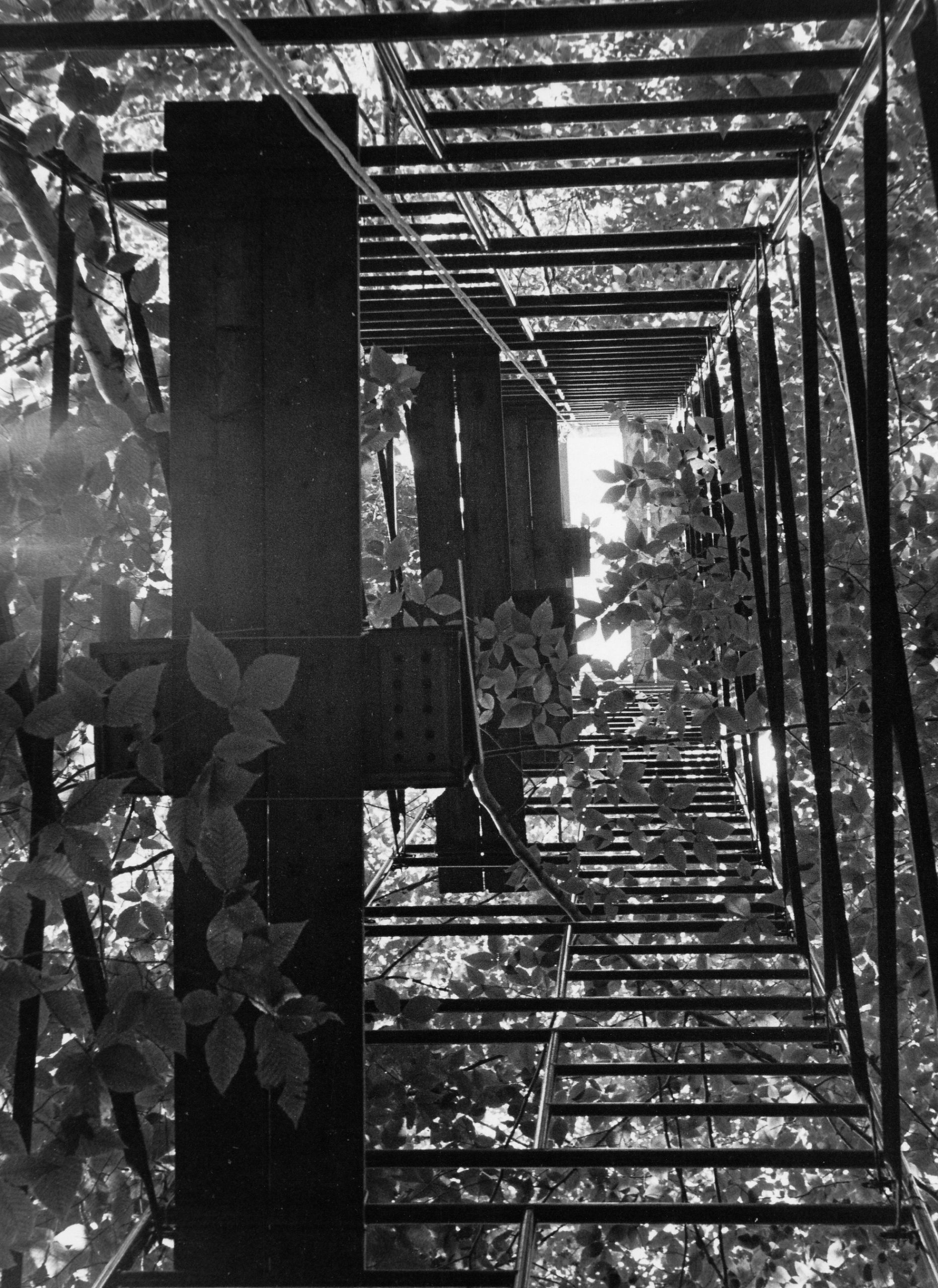
Dave called, right after Tom, “Ten [leaves], one [number of insects], fourth [instar].”
Tom S. followed quickly with “50; 2, third; 1, fourth, and 2 geometrids (inchworm eggs).”
Frank hollered, taking his turn “60; zip [zero].”
Pat wrote frantically, trying to keep all the numbers straight and under the correct caller’s name.
Back at Pleasant View, Frank did the tabulation. He found out how many of each insect were on the 1,200 leaves at each of the three levels in each tree sampled. After sampling eight times and inspecting 172,800 leaves for each kind of tree, the researchers estimated the number of insects they could expect to find on the leaves of an average tree.
An estimate is an educated guess – a guess based on some facts already known. Knowing the number of leaves and the average number of insects per leaf, the researchers could estimate the number of insects in their plots and in the whole experimental forest. By doing the same sampling each year, they could compare each year’s results with the first reliable year’s samples. The sampling would tell whether the number of insects was increasing, decreasing, or staying the same. The more leaves inspected, the smaller the guessing error and the closer to the real number the scientists would come. Ideally, they would look at all the leaves in the forest on the same day, but that, of course, would be impossible.
Trying to schedule Rod for good-weather days was hard. Weather forecasters had their troubles predicting too. Mostly, the researchers were lucky.
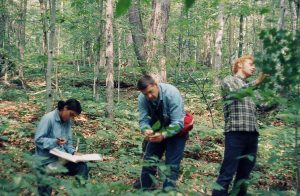
But one morning everyone was working as quickly as possible to finish counting the required number of leaves. Although the sky overhead was sunny, rolling peals of thunder sounded. To the experienced forest worker, that meant a thundershower. As the thunder got louder, a circle of clouds darkened and moved inward, filling the sunny space over the forest. Suddenly the light was turned off. The researchers felt as if they had stepped into a dark closet and the door was closing. Eyes accustomed to the light had not accommodated to the quick change. Someone joked, “Where’s your flashlight?”
Rod reached the forest floor as “20; zip” finished the leaf count and peals of thunder brought buckets of rain. Pressing close to the tree trunks, the researchers hoped the leaves and limbs above would act as an umbrella. At first they stayed dry as the floor around them turned wet and slippery. But after ten minutes “umbrellas” began to leak. As they got wetter and wetter, the researchers felt colder and colder. With nothing to lose, they made their way directly back to the truck, trying not to slip and add injury or mud to chilled wetness. The metal notebook was tightly closed. The day’s data wouldn’t wash away.
Besides a tree climber, the investigators decided to use a steel tower. The ornithology, ecology, and entomology researchers, with the help of their students and summer workers, became tower builders. Leveled on railroad ties, the heavy steel six-foot scaffolding grew like a column of tinker-toys. One open square was attached to another. The weight of each section held the tower in place. But as it grew taller, it swayed. Workers attached strong guy lines to each upper corner of the tower and anchored them near the forest floor. The lines held the tower securely balanced. Now workers would not get seasick as they climbed the tower to watch caterpillar larvae on the leaves in the treetops. Several people chose not to look down, since they suffered from slight cases of acrophobia, or fear of heights. It was a good place to get a suntan, high in the canopy.
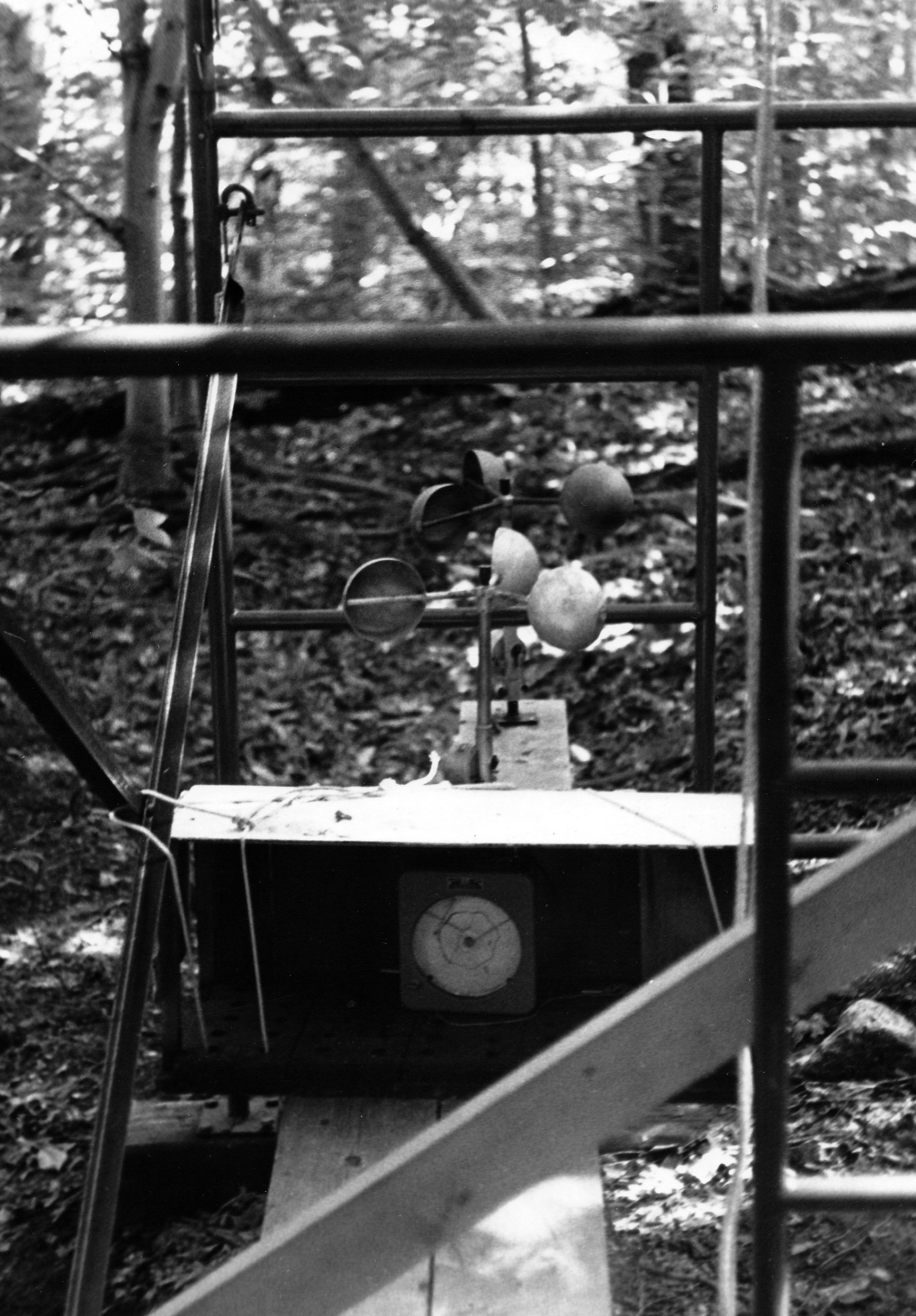
Boards placed across the beams at several levels held recording thermometers. Researchers stood on the platforms to count insects. Tower data were compared with and added to limb-cutting data.
Temperature data were included with insect data. Someone might be interested to learn whether temperature affected insect numbers at the altitude where they were found.
The researchers planned to place malaise traps at different levels on the tower and take samples from the forest floor to the treetops. Some insects had limited elevation levels in their life histories. If all elevations were not sampled, some kinds of insects might go undetected.
But plans and methods changed as researchers learned from experience and got new ideas from other people and places. They adapted such ideas to meet their own needs. The suction trap started Dick thinking and inventing. He would have to wait for more malaise traps. The company was out of them. Suction traps were available – he had had two shipped to New Hampshire from England.
Dick figured out another way to sample insects at varying elevations in the forest. The highest tree limbs near the tower were used to hold ropes tied to the traps. Pulleys raised and lowered the traps to any height. Hoisting the traps into the treetops and down to the forest floor worked very well.
One trap remained all day at one level. The next day the same trap collected at a second level and so on through five levels and five days. The second trap changed levels every three hours during the day, with no changes between 8 P.M. and 8 A.M. the following morning. After five days the traps switched jobs and carried out new schedules. Disks fell and collected hourly samples of insects throughout the day, every day. The recording thermometers on the tower traced the temperatures at the five levels on their graph-paper-covered drums. Each hourly collection of insects had the date, level, hour, and temperature recorded on its envelope.
Craig devised another way of getting up into the middle levels of tall trees – a ladder. His first ladder let him down because the plastic connection from the ladder to the tree was not sturdy enough. Luckily he grabbed a branch that broke his thirty-foot fall. Craig was philosophical about his broken invention: “It now rests with all the other inventive failures on the Hubbard Brook junk heap!” His second ladder was held in place by rigid iron piping. This one worked. He could take his poison bags higher up the tree and sample the insects in the branches. He discovered what insects were on the “cafeteria menu” awaiting selection by his black-throated blue warblers.
Collecting insects and frass, examining bird’s stomachs, and counting insects on leaves were all ways to get information about insects.
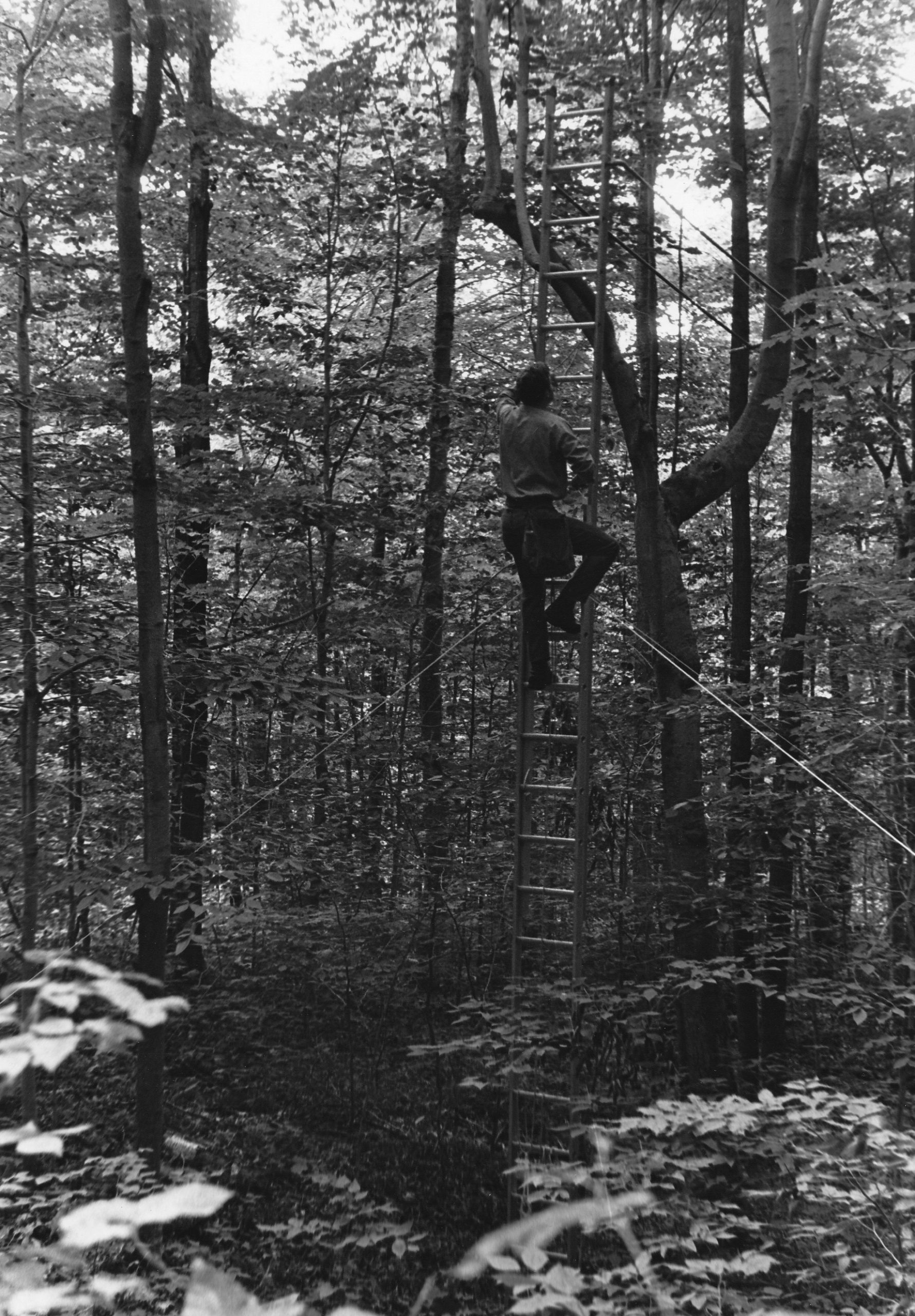
Litter-sorting a measured area of forest floor was another way to collect insects. Once every two weeks an empty square frame about 20 x 50 centimeters was sunk into the litter on the forest floor. Everything inside the square was placed in a plastic bag. The bag was tied and the sample dated. Later, on a table in the dining room or on the front porch of Pleasant View, the litter was spread on a tray and sorted by hand. All the insects were removed. Identifying, counting, and preserving samples of each kind of insect followed.
Bird stomachs were also dissected. A microscope was used to identify insect parts. These findings told exactly which insects the birds had eaten.
Frass-collecting was done by placing paper filters in white plastic funnels. Three-foot sticks stuck into the ground held the funnels in place at special spots on the birders’ grid map.
Wet paper filters tore easily. Rain added to the difficulty of getting good samples and typical numbers. The frass fell through torn paper funnels. This type of problem existed for all the researchers working in the outdoor lab, where control of all the variable things that can happen was impossible. Samples frequently had to be taken again and again. Days, weeks, months, or years might be added before reliable samples and numbers could be worked into formulas that revealed forest secrets.
All these trapping and collecting methods helped tell how many insects were in the woods, which insects were most plentiful, and which insects were in the birds’ food chains.
To help solve the researchers’ third problem, help in identifying insects, another Tom came to claim a bed at Pleasant View. The staff was fortunate to find an undergraduate student trained in entomology. Tom Baker planned to become an entomologist. He had a good insect background as well as keen interest. He was a careful observer and knew how to follow a key, identifying the insects as to order and family. He also knew how to preserve insects by a standard museum technique, drying specimens on pins. His insect labels were neat and accurate.
Like Joe, Tom needed good eyes. He spent many many hours a day peering into his binocular microscope. He carefully examined insect parts taken from bird stomachs. With his keying manual open beside the binoc, he looked at whole insects, noticing special features that identified them.
Tom not only keyed insects, analyzed bird stomach contents, pinned, and labeled, he also collected specimens. Collecting was a good change in activity from the steady sitting at the binoc.
With his net, Tom swept the air in the forest study areas. Sometimes he swept the air above the fields in front of Pleasant View just for practice and to satisfy his curiosity. He wanted to see what was there and how field insects compared with the forest insects.
His forest sweeps were made one or two times a week at regular times and at special places on the grid system. That is one important thing about data-collecting. The researchers do not collect on whim – whenever they feel like it. They collect regularly in a set manner. This is the only way investigators can accurately compare one day’s collecting with another and one year’s collecting results with another year’s results.
Tom also did litter-sorting. He collected and tried to identify grubs and insect life of all kinds in any stage – larva, pupa, adult. He counted the organisms and sorted out the ones he didn’t know. For many, there was no way to get a name. Later he tried to key out as many unknown as he could. In this way he learned to recognize the insects by sight.
The new entomology team attacked the insect study as tenaciously as the insects attacked the researchers. With hard work, luck, and time, a gap in the eco-puzzle would slowly be pieced together and filled.
